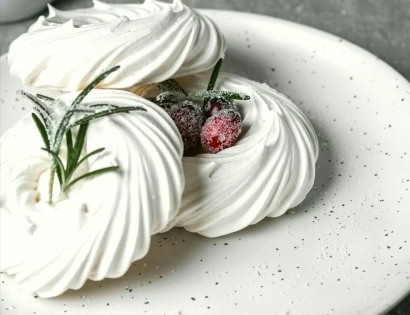Adding a leavening agent to the batter makes it easy to make a cake rise, but it’s much more difficult to make it rise without it. For a cake to rise naturally, it must rely on the expansion of air.
Therefore, the preparation of meringue, which traps air bubbles, is crucial. It’s not enough to just whip it; the goal is to create a “strong meringue that resists deflating.”
How to make meringue?
The Role of Sugar
Meringue is made from egg whites and sugar. Whisking the egg whites incorporates air, creating bubbles. While this alone will quickly dissipate the bubbles, adding sugar creates viscosity, resulting in a fine, stable texture with minimal fluctuations. This results in a strong meringue that resists deflating.
However, the addition of sugar requires careful attention. Adding too much sugar at once will inhibit foaming, while adding too little will result in excessive bubbles. However, if added at the right time, the membranes around the bubbles will become stronger, creating a firm, resistant meringue.
How to create fine bubbles?
The difficulty lies in the fact that stable bubbles with a fine, stable texture are invisible to the naked eye. Although we use a machine to whip the meringue, it cannot perfectly create a firm meringue. Therefore, the final step still relies on the feel of the hand to recreate the fine bubbles.
The most difficult part is to use a whisk to stir the meringue back and forth, judging the quality of the meringue by the feel of the whisk.
How to judge the quality of meringue?
There is only one way to visually confirm the quality of the meringue: let it rest for 2-3 minutes after you think it’s done. You can tell by the changes in the meringue during rest. If it’s not quite right, re-whip it before using.
If there’s no change, it’s a good sign, but don’t be complacent. After that, you need to use a whisk to align the tiny bubbles, which are invisible to the naked eye. Whether the tiny bubbles are neatly arranged can only be determined by feel.
The secret to mastering this feeling is to use a fixed amount of egg whites and sugar before becoming proficient in making meringue. By consistently using the same amount, your hand will naturally develop a feel for it and gradually memorize it. In stores, the amount of sugar added to the egg whites is fixed.
Meringue making varies depending on the type, size, and strength of the whisk, as well as the method of use and the specific meringue recipe. Getting used to your own whisk is crucial.
Two conditions are essential for making good meringue.
Use fresh eggs:
Although fresh egg whites don’t foam easily, once formed, bubbles are difficult to disappear, resulting in long-lasting bubbles. Stale egg whites may foam quickly, but they also disappear quickly and don’t last long.
Furthermore, bubbles that disappear quickly prevent the two ingredients from mixing properly and will not rise properly, making for a delicious cake.
Thick egg whites are viscous, making it difficult for air to enter, so they should be lightly mixed before use. However, if you overmix, the chiffon cake’s soft, springy texture will be lost, so “lightly mixing” is key.
Refrigerate until ready to use:
Refrigerate the egg whites until you begin working with them. While they’re less prone to foaming than egg whites at room temperature, they can still create fine, stable bubbles.
Approximately 90% of chiffon cake failures are due to the quality of the meringue. Learn how to make excellent meringue bit by bit, building upon your experience with failure.


Leave a Reply